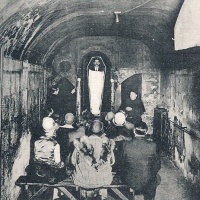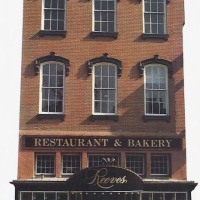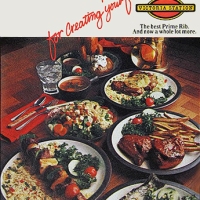The topic of hat checking in restaurants, nightclubs, and hotels, a popular subject in early 20th-century journalism, is so full of lore that it’s hard to know what to believe. Here’s what seems to be the story as best I can determine.
Hat checking in restaurants started as an independent money-making enterprise around 1900, beginning in New York City and gradually spreading westward. Before that, men took their hats into dining rooms, placing them under their chairs. (In cheap restaurants they kept them on while eating.)
It was considered perfectly fine for women to wear their hats at the table.
But hat checking for men wasn’t really new. It was common at fancy-dress balls in the 1800s. Many regarded it as a scam. An organization or group would throw a ball in a large venue such as Madison Square Garden. Tickets were advertised at the high price of $5. However, hardly anyone bought a ticket, getting them free instead from saloon keepers. When guests arrived at the ball they were required to check their hats, for which they were charged $2, the true price of admission. Those in the know referred to these balls as “hat check affairs.”
 Around 1900 restaurants began granting concessions to entrepreneurs who offered to pay them substantial sums to run a hat checking service. At first many were staffed with immigrant boys who were rudely persistent in demanding that male guests surrender their hats before entering the dining area. Gradually, the boys were replaced with attractive young women who used honey rather than vinegar to induce men to give up their hats. Upon exiting the restaurant patrons were expected to leave a tip of at least 10 cents, up to 25 cents by the 1930s.
Around 1900 restaurants began granting concessions to entrepreneurs who offered to pay them substantial sums to run a hat checking service. At first many were staffed with immigrant boys who were rudely persistent in demanding that male guests surrender their hats before entering the dining area. Gradually, the boys were replaced with attractive young women who used honey rather than vinegar to induce men to give up their hats. Upon exiting the restaurant patrons were expected to leave a tip of at least 10 cents, up to 25 cents by the 1930s.
Concession owners paid thousands of dollars a year for the privilege of running a hat check service and, often, of supplying washroom attendants as well. In nightclubs they provided women to sell cigarettes and flowers. In the early years the amounts paid for these concessions allegedly figured as important contributors to nightclub profits.
 All the tips collected by hat checkers went to concession owners, while the attendants received a low hourly wage. Newspaper stories revealing this set-up were perennials from 1910 into the 1950s, suggesting that there were always plenty of people for whom it was news that hat check “girls” didn’t keep the tips.
All the tips collected by hat checkers went to concession owners, while the attendants received a low hourly wage. Newspaper stories revealing this set-up were perennials from 1910 into the 1950s, suggesting that there were always plenty of people for whom it was news that hat check “girls” didn’t keep the tips.
 The menial job of hat checker was infused with glamour by gossip columnists and a number of Hollywood movies [top photo: Hat Check Girl, 1932]. This no doubt helped attract fresh recruits – including aspiring actresses who hoped to be “discovered” — in what was a high turnover, dead-end occupation. Want ads sought “attractive girls with pleasing personalities.” Meeting daily tip quotas through appearance and demeanor was a key to survival in what today is recognized as a “pink collar” job, i.e., one supposedly requiring no special abilities but demanding strenuous emotional labor. Acting talent came in handy. Occupants of the job became quite adept in shading the meaning of “Sir!” and “Thank you.”
The menial job of hat checker was infused with glamour by gossip columnists and a number of Hollywood movies [top photo: Hat Check Girl, 1932]. This no doubt helped attract fresh recruits – including aspiring actresses who hoped to be “discovered” — in what was a high turnover, dead-end occupation. Want ads sought “attractive girls with pleasing personalities.” Meeting daily tip quotas through appearance and demeanor was a key to survival in what today is recognized as a “pink collar” job, i.e., one supposedly requiring no special abilities but demanding strenuous emotional labor. Acting talent came in handy. Occupants of the job became quite adept in shading the meaning of “Sir!” and “Thank you.”
 Among the stresses of the job was the necessity to be gracious with patrons who flirted, pinched, left poor tips, and sometimes grew angry and slung insults. Hearing over and over how men had paid more in tips than their hats were worth became tiresome. So did laughing at jokes. Cartoonist W. E. Hill perfectly captured the facial expression of a woman preparing to respond hilariously to a bad joke.
Among the stresses of the job was the necessity to be gracious with patrons who flirted, pinched, left poor tips, and sometimes grew angry and slung insults. Hearing over and over how men had paid more in tips than their hats were worth became tiresome. So did laughing at jokes. Cartoonist W. E. Hill perfectly captured the facial expression of a woman preparing to respond hilariously to a bad joke.
Some hat checkers went to court to claim tips as theirs, but did they ever win? I doubt it. Many hotels and restaurants avoided the stigma associated with hat checking by running their own services while making it clear that tips were unnecessary. The Exchange Buffet chain advertised in 1914, “No hat-boy to hold you up.” Schraffts’ deposited tips in an employee sick benefit fund. Legislation was offered in some cities and states requiring that hat check stations either post a notice stating that tips went to a concession owner or turn them over to the attendants.
Overall, hat checking thrived best in big-city nightclubs visited mainly by tourists.
 One of the rare hat checkers who beat the system was Renee Carroll, who ran her own concession at Sardi’s. The daughter of a New York City rabbi, she changed her name from Rebecca Shapiro and became part of the entertainment world, a Broadway personality known for witty quips. She appeared in movies, published a book about her experiences with celebrity customers, authored a gossip column, and backed theatrical productions.
One of the rare hat checkers who beat the system was Renee Carroll, who ran her own concession at Sardi’s. The daughter of a New York City rabbi, she changed her name from Rebecca Shapiro and became part of the entertainment world, a Broadway personality known for witty quips. She appeared in movies, published a book about her experiences with celebrity customers, authored a gossip column, and backed theatrical productions.
By the mid-1920s, with many people going to restaurants and nightclubs by car, hat checking declined as hats were left in the car. By the mid-1930s fewer men wore hats, especially the young. Hat checking in restaurants can still be found but no one is forced to use it and the glamourous hat check girl is no longer a figure of popular culture.
© Jan Whitaker, 2018













 It's great to hear from readers and I take time to answer queries. I can't always find what you are looking for, but I do appreciate getting thank yous no matter what the outcome.
It's great to hear from readers and I take time to answer queries. I can't always find what you are looking for, but I do appreciate getting thank yous no matter what the outcome.



Pingback: Hat Check Girl or Check Room Girl – Cultureify
Jan, love this story! All through it I was wondering why the men even brought their hats into the restaurant, then you end by saying, “By the mid-1920s, with many people going to restaurants and nightclubs by car, hat checking declined as hats were left in the car.” I was forgetting about public transportation.
Fascinating, Jan! Thanks for the inside look.
Thank you, Kathy!
Here’s why women were not expected to remove their hats: often, it would have been impossible due to hairstyles (and hatpins! A woman’s only weapon, in many cases, back then!)
That was interesting. ThanksxxxxxxM🐦😎🚗💟
On Sun, Mar 25, 2018 at 9:32 AM, Restaurant-ing through history wrote:
> victualling posted: ” The topic of hat checking in restaurants, > nightclubs, and hotels, a popular subject in early 20th-century journalism, > is so full of lore that it’s hard to know what to believe. Here’s what > seems to be the story as best I can determine. Hat checking” >
Always good to read your stories. After leaving FB its good to continue to see your research.
Hope you and Barton are doing well.
Hi Tom, Glad to hear from you — I wondered where you went!